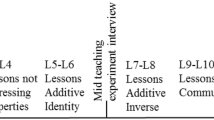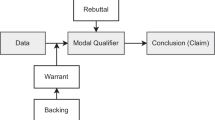Abstract
The aim of the study is to describe the semiotic resources that children used in mathematical explanations of hypothetical situations. The empirical material consists of a short video from a Norwegian kindergarten, where four 5-year-old children and a kindergarten student teacher discuss real and imaginary page layouts of a photo book. When explaining their reasoning about the amount of photographs in the layouts, the children used oral language, gestures and physical objects like number charts. The use of these resources in different kinds of explanations is discussed. Our results suggest that by using a range of semiotic resources, children are able to provide explanations of hypothetical situations using mathematical ideas at a younger age than previously suggested.
Access this chapter
Tax calculation will be finalised at checkout
Purchases are for personal use only
Similar content being viewed by others
References
Alibali, M. W., & Nathan, M. J. (2012). Embodiment in mathematics teaching and learning: Evidence from learners’ and teachers’ gestures. Journal of the Learning Sciences, 21(2), 247–286.
Donaldson, M. L. (1986). Children’s explanations. Cambridge: Cambridge University Press.
Edwards, L. D. (2009). Gestures and conceptual integration in mathematical talk. Educational Studies in Mathematics, 70(2), 127–141.
Gelman, R., & Gallistel, C. (1978). The child’s understanding of number. Cambridge, MA: Harvard University Press.
Goldin-Meadow, S. (1998). The development of gesture and speech as an integrated system. New Directions for Child Development, 79, 29–42.
Johansson, M., Lange, T., Meaney, T., Riesbeck, E., & Wernberg, A. (2014). Young children’s multimodal mathematical explanations. ZDM—International Journal on Mathematics Education, 46(6), 895–909.
McNeill, D. (1992). Hand and mind: What gestures reveal about thought. Chicago, IL: University of Chicago Press.
McNeill, D. (2005). Gesture and thought. Chicago, IL: University of Chicago Press.
Meaney, T. (2011). Only two more sleeps until the school holidays: One child’s home experiences of measurement. For the Learning of Mathematics, 31(1), 31–36.
Radford, L., & Sabena, C. (2015). The question of method in a vygotskian semiotic approach. In A. Bikner-Ahsbahs, C. Knipping, & N. Presmeg (Eds.), Approaches to qualitative research in mathematics education (pp. 157–182). New York: Springer.
Roth, W.-M. (2001). Gestures: their role in teaching and learning. Review of Educational Research, 71(3), 365–392.
Sabena, C. (2008). On the semiotics of gestures. In L. Radford, G. Schubring, & F. Seeger (Eds.), Semiotics in mathematics education: Epistemology, history, classroom, and culture (pp. 19–38). Rotterdam: Sense Publishers.
Saar, T. (2013). Articulating the immanent: Children unfolding numbers. Global Studies of Childhood, 3(3), 310–317.
Yackel, E. (2001). Explanation, justification and argumentation in mathematics classrooms. In A. Cockburn & E. Nardi (Eds.), Proceedings of the 26th Annual Conference of the International Group for the Psychology of Mathematics Education (Vol. 1, pp. 9–25). Norwich: PME.
Author information
Authors and Affiliations
Corresponding author
Editor information
Editors and Affiliations
Rights and permissions
Copyright information
© 2020 Springer Nature Switzerland AG
About this chapter
Cite this chapter
Severina, E., Meaney, T. (2020). The Semiotic Resources Children Use in Their Explanations of Hypothetical Situations. In: Carlsen, M., Erfjord, I., Hundeland, P.S. (eds) Mathematics Education in the Early Years. Springer, Cham. https://doi.org/10.1007/978-3-030-34776-5_11
Download citation
DOI: https://doi.org/10.1007/978-3-030-34776-5_11
Published:
Publisher Name: Springer, Cham
Print ISBN: 978-3-030-34775-8
Online ISBN: 978-3-030-34776-5
eBook Packages: EducationEducation (R0)




